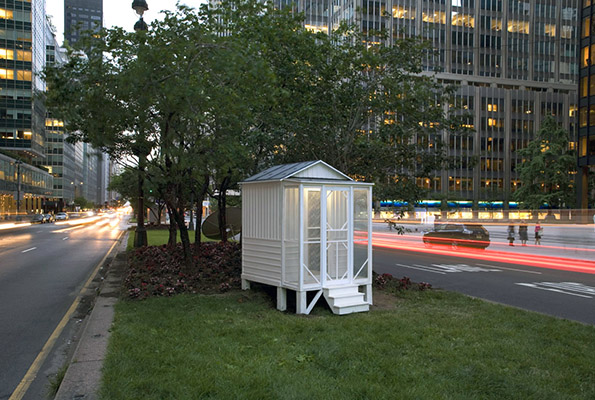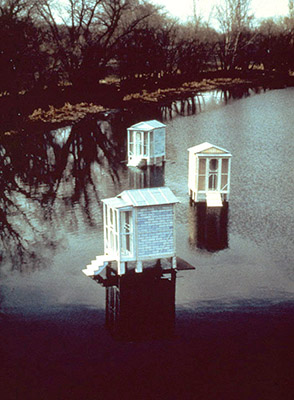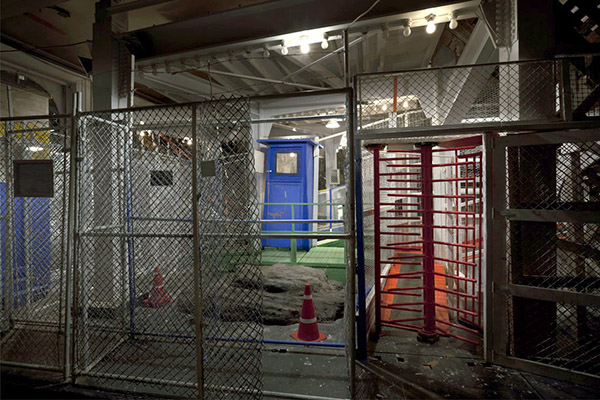
Tourist Cabins On Park Avenue, 2007, Park Avenue median at 52nd and 53rd Streets, mixed media with interior lighting and satellite dish, each cabin 78 x 52 x 72 inches.

Moccasin Creek Cabins, 1983, mixed media installation at Moccasin Creek, Aberdeen, South Dakota, each cabin 78 x 54 x 72 inches.

Coney: Night Maze (detail), 1996-2009, mixed media with sound, 150 x 324 x 232 inches.
BIOGRAPHY
Donna Dennis is a sculptor, painter, and printmaker based in New York. Dennis’s work is held in collections including the Brooklyn Museum, the Cleveland Art Museum, the Microsoft Collection, the Walker Art Center, Ludwig Forum fur Internationale Kunst in Aachen, Germany, the Indianapolis Museum, the San Diego Museum of Art, the Smithsonian American Art Museum, and the Neuberger Museum. She has been honored with a Guggenheim Fellowship, several National Endowment Fellowships, and Pollock-Krasner Foundation grants, the Merit Award in Sculpture from the American Academy of Arts and Letters and the Anonymous Was a Woman Award. She was elected to the Academy in 2010 and is Professor Emerita at Purchase College, SUNY.
PRESS RELEASE
SIXTH ANNUAL ARTISTS’ LEGACY FOUNDATION AWARD GIVEN TO SCULPTOR DONNA DENNIS
OAKLAND, CALIFORNIA—September 21, 2012—The Artists’ Legacy Foundation is pleased to announce that its sixth annual Artist Award of $25,000 will be presented to noted American sculptor Donna Dennis. The purpose of the Artist Award is to recognize and honor the career and accomplishments of an outstanding visual artist whose primary medium is painting or sculpture.
Each year, ten to fifteen painters and sculptors are nominated for the Artist’s Legacy Foundation’s Artist Award; the nominators and jurors are art world peers with expertise in their fields. The Foundation’s 2012 panel of jurors included painter Beverly McIver, artist Lesley Dill, and poet, art critic and professor emeritus at the San Francisco Art Institute Bill Berkson, who says, “Donna Dennis is a quiet wonder. For over 40 years, she has been making these marvelous structures that become places of both fond recognition and mystery.”
All candidates for this award are nominated anonymously, and the artists are unaware they are under consideration until the award is granted.
When informed of the award, Dennis was walking down the street using her cellphone. “I told her that I had some good news and suggested that she might want to sit down,” says Artists’ Legacy Foundation Executive Director Sharon Tanenbaum. “So she settled for stopping and leaning against a wall. She was overwhelmed and said the timing couldn’t be better; she’d just finished a monumental piece for an upcoming exhibition, and she is gearing up to start another major work, which this award will now help make a reality.”
The 2012 award recipient, Donna Dennis, has been a practicing artist for the past four decades. Born in 1942 in Springfield, Ohio, she moved to Rye, New York in 1949 and received her BA with a major in art in 1964 from Carleton College in Minnesota. She furthered her art pursuit at College Art Studies Abroad in Paris, before returning to the U.S. in the mid-1960s to study at the Art Students League in New York, where she currently resides. In describing her passion for her work, Dennis asserts, “I cannot remember a time when I did not want to be an artist.”
In addition to her Guggenheim Fellowship and status as both a Whitney Biennial alumnus and the recipient of several NEA Fellowships, Dennis has exhibited throughout the world in major museums as well as public art installations. Her work was featured in two Venice Biennales and exhibitions at the Tate Gallery in London, Ludwig Forum Internationale Kunst, in Aachen Germany, the Hirshhorn Museum and Sculpture Garden at the Smithsonian Institution in Washington DC and numerous others.
In the mid 1970s Donna Dennis first came to the attention of both critics and the public with her large architecturally inspired installations from her Subway Stations and Tourist Cabins series. She is among a group of noted artists including Alice Aycock, Siah Armajani, and Mary Miss who pushed sculpture toward the domain of architecture. Deborah Everett, writing for the magazine Sculpture, even asserted that Dennis “actually made architecture,” specifically, “American vernacular architecture” that was then transformed into sculpture when Dennis “created her earnest, plain-spoken ‘Tourist Cabins’ at the outset of her career,” which Everett then notes, “had the impact of cultural icons.”
The tourist-cabin inspired sculptures are roughly scale and contain details such as windows, electric lights, beds, curtains and screening. They have been exhibited indoors at the Whitney Museum of American Art, New York; Walker Art Center, Minneapolis; Hirshhorn Museum and Sculpture Garden, Smithsonian Institution, Washington DC; Tate Gallery, London; and the Venice Biennale. When presented outdoors they were seen in such settings as New York’s City Hall Park, Storm King Art Center in Mountainville, NY, Moccasin Creek in Aberdeen, South Dakota (where they were afloat), and other public venues. Each new setting over the years has produced a new way of thinking about these metaphorical works inspired by American roadside architecture.
Dennis’s work is in many prominent collections including those of the Brooklyn Museum, Cleveland Art Museum, the Microsoft Collection in Seattle, the Walker Art Center in Minneapolis, the Ludwig Forum fur Internationale Kunst in Aachen, Germany, the Indianapolis Museum, the San Diego Museum of Art and the Smithsonian American Art Museum in Washington DC.
Generously deconstructing her architectural prototypes with a language that is both evocatively detailed and highly formal, her work is steeped in a deep well of personal emotion.
Beginning with the early Hotel series (1972-74) and Tourist Cabin Porch (Maine) (1976), Dennis has always seen her work as representing stopping places, points of passage on a metaphorical journey through life. Her early subway-inspired works led her to imagine exploring dark, subterranean, subconscious realms, envisioning a track (or river) that divided again and again, allowing for infinitely expanding possibilities. Tourist Cabins on Park Avenue, constructed in 2007, transformed the Park Avenue median between 52nd and 53rd Streets in Manhattan.
Deeply affected by the women’s movement of the early ’70s with its potential for recasting the entire language of art, Dennis’s Deep Station paralleled the shifting consciousness of the era with the shifting going on deep in the tectonic plates of the earth itself. Later, themes of death and the underworld would appear throughout BLUE BRIDGE/red shift resulting in “an almost mythic invocation of mortality” according to George Melrod, writing in Art in America.
Dennis’s much anticipated Coney Night Maze is scheduled to premiere in June 2013 at the Neuberger Museum of Art in Purchase, NY. Coney Night Maze represents thirteen years of labor – some of it under the shadow of 9/11 that continues all of these themes but with a new conclusion. The large, complex sculptural installation of the maze, with its dead ends, locked gates and mute signs that provide no words of direction at first creates a sense of dislocation, confusion, and a feeling of being caught. Two ticket booths stand witness but give no aid. How does one escape? How does one reach the track and its promise of a ride?
